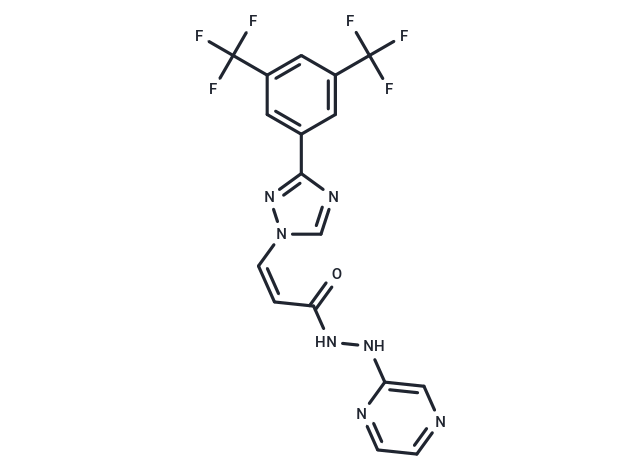Shopping Cart
- Remove All
 Your shopping cart is currently empty
Your shopping cart is currently empty

Selinexor (KPT-330) is a small molecule inhibitor of CRM1 with selective and oral activity. Selinexor blocks the cell cycle, induces apoptosis, and has antitumor activity for the treatment of multiple myeloma.

| Pack Size | Price | Availability | Quantity |
|---|---|---|---|
| 2 mg | $39 | In Stock | |
| 5 mg | $74 | In Stock | |
| 25 mg | $281 | In Stock | |
| 50 mg | $422 | In Stock | |
| 100 mg | $481 | In Stock |
| Description | Selinexor (KPT-330) is a small molecule inhibitor of CRM1 with selective and oral activity. Selinexor blocks the cell cycle, induces apoptosis, and has antitumor activity for the treatment of multiple myeloma. |
| In vitro | METHODS: Six T-ALL cells, MOLT-4, Jurkat, HBP-ALL, KOPTK-1, SKW-3 and DND-41, were treated with Selinexor (0-1000 µM) for 72 h. Cell growth inhibition was detected using Cell Titer Glo assay. RESULTS: Selinexor treatment inhibited T-ALL cell growth with IC50 values of 34-203 nM. [1] METHODS: Multiple myeloma cells MM1S were treated with Selinexor (100 nM) for 8 h. The expression levels of target proteins were detected by Western Blot. RESULTS: Selinexor treatment resulted in the accumulation of p53, IκB, p21 and p27 in the nucleus of MM1S cells. [2] |
| In vivo | METHODS: To assay antitumor activity in vivo, Selinexor (20-25 mg/kg) was administered by gavage to NSG mice harboring the human T-ALL tumor MOLT-4 three times per week for thirty-six days. RESULTS: Selinexor-treated mice exhibited significant inhibition of leukemia cell growth with significant survival benefit. [1] METHODS: To assay anti-tumor activity in vivo, Selinexor (20 mg/kg) was administered by gavage three times per week for four weeks to an NSG mouse model of primary AML in patients. RESULTS: Selinexor was cytotoxic to primary AML cells transplanted into mice. [3] |
| Alias | Selinexor, KPT-330 |
| Molecular Weight | 443.31 |
| Formula | C17H11F6N7O |
| Cas No. | 1393477-72-9 |
| Smiles | FC(F)(F)c1cc(cc(c1)C(F)(F)F)-c1ncn(\C=C/C(=O)NNc2cnccn2)n1 |
| Relative Density. | 1.55 g/cm3 (Predicted) |
| Storage | Powder: -20°C for 3 years | In solvent: -80°C for 1 year | Shipping with blue ice. | |||||||||||||||||||||||||
| Solubility Information | 10% DMSO+40% PEG300+5% Tween 80+45% Saline: 8.2 mg/mL (18.5 mM), In vivo: Please add the solvents sequentially, clarifying the solution as much as possible before adding the next one. Dissolve by heating and/or sonication if necessary. Working solution is recommended to be prepared and used immediately. H2O: < 1 mg/mL (insoluble or slightly soluble) Ethanol: 38 mg/mL (85.72 mM), Sonication is recommended. DMSO: 55 mg/mL (124.07 mM), Sonication is recommended. | |||||||||||||||||||||||||
Solution Preparation Table | ||||||||||||||||||||||||||
Ethanol/DMSO
DMSO
| ||||||||||||||||||||||||||

Copyright © 2015-2025 TargetMol Chemicals Inc. All Rights Reserved.